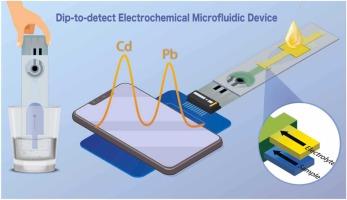Dip-to-detect electrochemical microfluidic device: Integrating sample collection and automated mixing for on-site detection of heavy metals
IF 3.7
1区 化学
Q1 CHEMISTRY, ANALYTICAL
引用次数: 0
Abstract
Human exposure to heavy metals poses a global threat due to their harmful health and environmental effects. Standard analytical methods rely on complex operations and sophisticated instruments, making them costly, labor-intensive, and limited in on-site suitability. This work presents a “dip-to-detect” electrochemical microfluidic device that enables direct sample dipping and automated electrolyte mixing. The device is made using stacked layers of transparent and double-sided adhesive films designed to enable sequential flow control. We implement a fluid-triggered valve to allow direct dipping and store the sample solution inside the channel without leakage. The electrolyte is added to the device without fixed-volume pipetting, activating the valve for rapid mixing with the sample solution. The device is equipped with a near field communication (NFC) controlled potentiostat for the portable detection of Cd(II) and Pb(II) with limits of detection of 90 ppb and 80 ppb, respectively. To validate its performance, the microfluidic device was tested with spiked industrial water samples. The device demonstrated good recovery, ranging from 102.2 % to 116.7 %. The dip-to-detect electrochemical microfluidic device eliminates the need for pipetting and manual mixing. This platform introduces a new alternative for field-deployable sensing and has the potential to inspire future designs focused on simple sample collection, automated reagent handling, and minimal user intervention.

浸测电化学微流控装置:集样品采集和自动混合于一体,用于现场重金属检测
由于重金属对健康和环境的有害影响,人类接触重金属对全球构成威胁。标准分析方法依赖于复杂的操作和精密的仪器,使其成本高,劳动密集,并且在现场适用性有限。这项工作提出了一种“浸入检测”的电化学微流控装置,可以直接浸入样品并自动混合电解质。该装置由透明和双面胶膜堆叠而成,旨在实现顺序流量控制。我们实现了一个流体触发阀,允许直接浸渍并将样品溶液存储在通道内而不会泄漏。将电解液添加到装置中,无需固定体积移液,激活阀门与样品溶液快速混合。该装置配备了近场通信(NFC)控制的电位器,用于便携式检测Cd(II)和Pb(II),检测限分别为90 ppb和80 ppb。为了验证其性能,用加标工业水样对微流控装置进行了测试。该装置具有良好的回收率,回收率在102.2 % ~ 116.7 %之间。浸入检测电化学微流体装置消除了移液和手动混合的需要。该平台为现场可部署的传感引入了一种新的替代方案,并有可能激发未来的设计,重点是简单的样品收集,自动化试剂处理和最小的用户干预。
本文章由计算机程序翻译,如有差异,请以英文原文为准。
求助全文
约1分钟内获得全文
求助全文
来源期刊

Sensors and Actuators B: Chemical
工程技术-电化学
CiteScore
14.60
自引率
11.90%
发文量
1776
审稿时长
3.2 months
期刊介绍:
Sensors & Actuators, B: Chemical is an international journal focused on the research and development of chemical transducers. It covers chemical sensors and biosensors, chemical actuators, and analytical microsystems. The journal is interdisciplinary, aiming to publish original works showcasing substantial advancements beyond the current state of the art in these fields, with practical applicability to solving meaningful analytical problems. Review articles are accepted by invitation from an Editor of the journal.
 求助内容:
求助内容: 应助结果提醒方式:
应助结果提醒方式:


